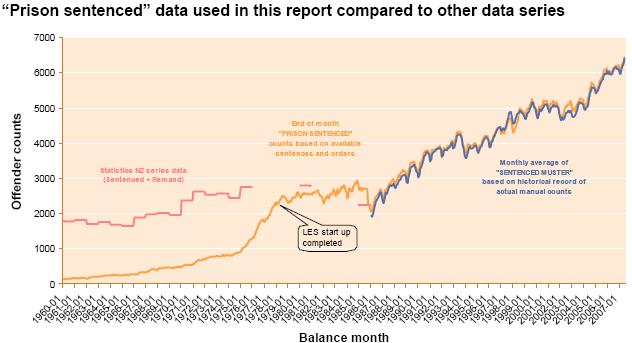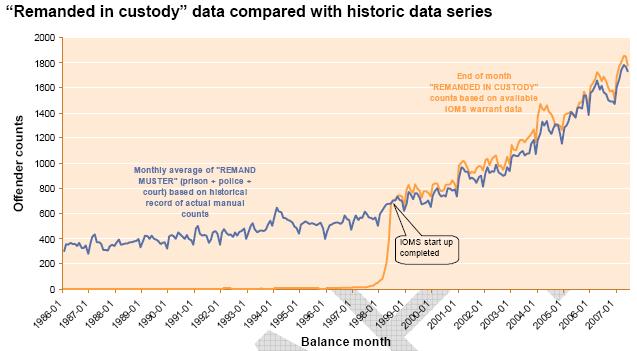11.4 Data quality
For reasons of completeness and internal data integrity, the data enrichment process has ensured that offenders and offender status are "conserved" over time. Specific electronic data relating to a Court or Parole Board directive has always been identified such that justifies a change in status.
Each offender status on each day is auditable to the extent that it can be traced back to an electronic record giving a date and directive mandated by the Courts or the Parole Board. There is one major exception to this rule. Prior to 2002 the available electronic parole and prison release directives were found to be somewhat patchy, and tapered off to there being none available within Correction’s databases prior to 1990. Thus the prison release directive data prior to 2002 has been supplemented with "proxy parole orders" derived from the gap between actual release dates recorded and running until the custodial sentence expiry dates.
A number of quality checks have been done including the following:
- Comparison of the offender "prison sentenced" snapshot trend numbers against the historical record of average actual musters trend. Excellent match, see below for more detail.
- Comparison of "prison sentenced" snapshot offender lists with historical lists of muster prisoners on the same days. Several days tested and a match obtained to within 98%.
- Comparison of counts from the community sentenced source data with historical reporting. Accurate matching is not possible due to different counting rules but the scale and shape of Ministry of Justice data gives confidence that the differences are mostly due to this report avoiding double counting offenders in different categories.
- Comparison of generated community sentenced against recent reports of probation service activity. An excellent match resulted with differences able to be explained by different counting rules.
In addition to holding records relating to offender’s directed status, Corrections also holds complementary data relating to actual manual prison muster records. The data sets closely align but are not identical as the actual offender disposition can be affected by issues such as deaths, escapes, movements to psychiatric facilities, hospital visits, court stays, and temporary releases etc. Also, both data sets can have data latency issues and errors. However, comparing the data-sets as shown below provides confidence that each is meaningful.
From the chart below, it can be seen that subsequent to the start-up of LES (the Law Enforcement System), the overall match between the "prison sentenced" and "sentenced muster" data appears healthy. The effect of back entering only criminal histories for those offenders managed post LES start-up is seen in the way prison sentenced numbers are only a proportion of muster numbers before 1976.
Remand episodes in this report are derived from Corrections’ electronically recorded remand directives which have proved difficult to analyse with actual management still done largely on paper-based systems rather than electronic ones. One of the issues has been that Corrections’ data does not currently include explicit closure of "remanded in custody" periods when bail has subsequently been granted. Another possible issue is the lack of explicit data on closure of remand directive records when an individual goes to Court and does not return due to being given a non custodial sentence or perhaps being acquitted. Also, when individuals are remanded in police cells and police haven’t requested the use of Corrections facilities for the remandee then the Corrections muster reporting processes exclude these remandees entirely. Most of these issues have been resolved with work-arounds.
Quality checks of the directed "remanded in custody" counts versus the actual manual muster counts show a gap of up to 100 extra individuals apparently directed to custody on any day relative to actual “remand muster” records. The overall match and pattern and meaningfulness of the directed status information appears however to be good. The following graph indicates the closeness of match between the two data-sets.
Thus, in summary, a number of data issues have surfaced during the preparation of this report as a result of the rigid requirement that offender status is conserved and carried forward from year to year unless a directive to change the status is located. Most issues identified have been managed or minimised in the meantime and the reader can be confident that the data-set used in this report is comprehensive and accurate within the limits of available data. While there remain some data inaccuracies in the IOMS data (as occur in any such collection), going forward the method used here will draw attention to such inaccuracies by virtue of the fact that the offender record will not conform to rules and norms thus allowing improvements to be made.
Overall, thanks to the introduction of the Law Enforcement System in the 1970s, it has been possible to build a continuous and reasonably accurate history of all New Zealand offenders spanning nearly 30 years.



